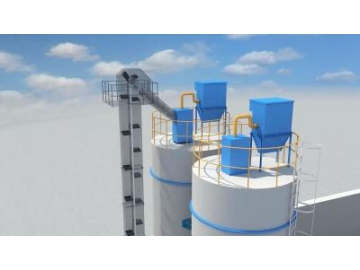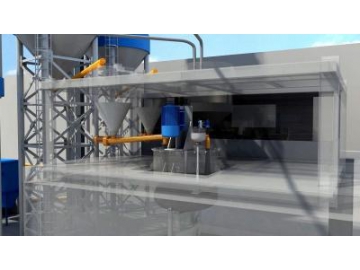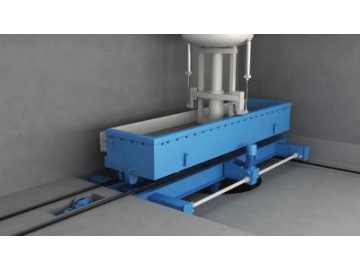AAC Panel Manufacturing Line
As one type of lightweight and porous panel, AAC panel can be used as external wall panel, partition board and roof panel. AAC panel adopts siliceous materials and calcareous materials as its main raw materials, and adopts aluminum powder as gas generation materials. Then with preservative treated reinforcing mesh, the AAC panel can be produced by mixing with water, pouring, pre-curing, cutting and autoclaving. We can offer you complete sets of equipment from material preparation to packaging in AAC panel production line.
The only difference between AAC panel and AAC block is that the inner of panel is equipped with steel bar. Therefore, extra drill rod insertion and drill rod pulling out are needed for AAC panel production.
Configure Reference
In AAC block production line, the common capacity is 15m3, 30m3 and 60m3 per year. Therefore, the parameters for the 2 types of production line are listed for your reference.
Our production lines feature an annual capacity of 5m3~60m3. Please contact us if you cannot find the information you need on the following pages. We will offer you valuable advice according to your needs.
Sand needs to be grinded and stirred to create the mortar. Then the lime powder and mortar need to be precisely weighted for batching in next process.
Precise Weighing
To guarantee that the dosage of raw materials is conform to the formula design, we adopt a Mettler Toledo sensor for precise weighing.
Uniform Granule
sometimes the lime processed by ball mill is cracked, but the size of granule is not uniform. In this case, we can offer classifying system for obtaining uniform granule. By this means, the lime is easier to mix with the mortar. Besides, lime powder point is not easy to form when stirring.
Stable Temperature
The temperature of mortar will affect the gas generation of aluminum powder, and ultimately affect the porosity and strength of finished products. Therefore, we adopts automatic monitoring and cooling system to control the temperature during mortar storage. When the temperature of the mortar exceeds the set temperature, the cooling system will automatically initiate.
Material Level Control
The storage tank for lime is equipped with whole course material level control system. If exceeding the material level, the raw material supply system will stop working automatically. If not exceeding the material level, workers will be warned for feeding the raw materials.
Environment Protection
Dust collector is equipped to effectively collect the dust produced in material preparation process, in order to avoid pollution to air and protect the health of workers.
In this process, the dosage of raw materials in each mold will be precisely weighed and blended.
Precise Weighing
The weighing scale is equipped with Mettler Toledo sensor to make the accuracy to be 5/1000. By this means, the uniformity of formula can be guaranteed.
Vibration Reduction
When designing the production line, the pouring part and mixing part that vibrate easily are separated from the batching part. In this way, the vibration can be reduced when batching, resulting in higher weighing accuracy.
High Speed Stirring
Double blade is equipped for high speed stirring and making the slurry more even.
Double Layer Stirring
Double layer stirring is designed for high strength and low volumetric weight product. After stirring in the first layer, the slurry will enter into the second layer for further stirring. At the same time, next weighing will be conducted in first layer. By this means, the uniformity of slurry can be improved and production speed can be guaranteed.
Evenly blended slurry will be automatically poured into the mold in this process.
Temperature Control
The whole course of temperature in pouring process can be automatically controlled. If the temperature detected by the sensor is relatively low in the pouring process, the motor operated valve for the steam pipeline will be automatically opened. In this way, high temperature steam will be entered to improve the temperature in the pouring process.
Automatic Operation
When reaching the pouring section, the empty mold will automatically send a signal to the poring section letting the system know that the mold is in position for pouring. After stirring, the valve will automatically open and the slurry will be poured into the mold. No manual labor is need in the whole process.
Bubble Reduction
The pouring arm will automatically descent to the bottom of mold before pouring. Then, pouring will be started from the bottom of mold. Then the pouring arm will rise as the material level. By this means, air can be avoid mixed in the pouring process, leading to no air bubble in the concrete block.
Bubble Discharge
High frequency vibrator will be inserted into the slurry after pouring for air discharge.
After finishing pouring, the mold loaded with concrete blocks will move forward automatically and reach the drill rod insertion section.
The locating system designed by us will automatically locate the mold and send the signal to the travelling crane for drill rod insertion. Then the travelling crane will automatically move to the above of the mold and insert the reinforcing mesh into the mold. After inserting the reinforcing mesh, the concrete panels will move to pre-curing process.
The mold poured with slurry will be pre-cured for some time under certain temperature to form the concrete block with certain hardness. Then the concrete blocks will be overturned and demolded for cutting.
Automatic Operation
The whole pre-curing process will be completed automatically. Besides, the pre-curing time for each mold will be displayed on the touch screen for direct observation.
Temperature Control
The whole course temperature in the pre-curing process will be controlled by the program. If the temperature is too low, the temperature control system will automatically open steam pipeline valve for high temperature steam. If the temperature is too high, the temperature control system will automatically close steam pipeline valve for rise of temperature.
Whole Process Monitoring
If in need, we can real time monitor the speed and temperature in the gas generation process of concrete blocks. By this means, clients can learn if the concrete blocks in the pre-curing process can meet the requirements for timely adjusting of the formula.
The concrete panels will be conveyed to certain location for drill rod pulling out after pre-curing. The lifting appliance will move to the above of the mold and pull out the drill rod and leave the steel bar inside.
The mold will be conveyed to the overturn table by friction drive wheel for following cutting after pulling out the drill rod.
The concrete blocks will be conveyed to the cutter to cut each side.
High Precision Cutting
Main cutting parts of cutter are all manufactured by CNC plano milling machine, including the pathway for cutting, the transfer trolley for cutting, as well as the curved plate and swing axle for locating the steel wire used for cutting. The cutting error of length is within 2mm, the cutting error of height and width is within 1mm.
Smooth Cutting Surface
In order to minimize the deformation of steel wire when cutting and make the cutting surface smooth, we shorten the length of the steel wire used for cutting. No large vibration will be caused due to high precision of cutter. Therefore, the cutter can adapt to higher liner speed for further increasing the surface cleanness.
High Speed Cutting
Cutting speed can be guaranteed by two transfer carts in the whole cutting process. The cutting time for each mold is less than 3.5 min.
Stable Overturn
After cutting, under the control of hydraulic buffer system, concrete block bottom cutter will turn the concrete blocks 90 degrees to remove the hard waste on the bottom of the concrete blocks. Then the concrete blocks will be turned back. Due to precise control of hydraulic buffer system by the proportional valve, the whole overturn process is stable and void of vibration. As a result, the damage rate is held under 0.5%.
Flexible Process
For thinner blocks and panels, we can modify the final overturn process by getting rid of turning back the blocks or panels after removing the hard waste. By this means, the bonding strength between blocks or panels can be decreased, and the damage rate for separating the blocks or panels can be reduced.
The cut concrete blocks will be lifted to the autoclave trolley and grouped into the concrete curing autoclave for high temperature autoclaving.
Real Time Monitoring
The data about temperature and pressure in the autoclaving process will be transmitted to the electronic control system in real time. Besides, the data can be printed. However, the temperature and pressure need manual control.
In time Drainage
During the temperature rising and pressure rising stage in the autoclaving process, amounts of condensed water will be produced. These condensed water needs to be discharged in time, because these water has a great influence on the effect of autoclaving. We can offer clients 4 types of drainage system, including automatic type and manual type. Clients can choose suitable type depending on their needs.
The autoclaved concrete blocks will be conveyed out of the concrete curing autoclave and separated by the concrete block separator. Then the concrete blocks will be stocked, packed or loaded.
Low Damage Rate
The strength between the clamping arm and separator is monitored by the pressure sensor and auto controlled by PLC system. As a result, the panel is not easy to be damaged.
Efficiency Improvement
The separated blocks will be clamped and conveyed to the pallet or 2 strand chain conveyor, leading to no need for manual handling. Besides, we can offer clients block pallet machine for automatically send the pallets to the chain conveyor, resulting in high efficiency.
Recycling Production
After the concrete blocks being clamped, the empty pallets will automatically move forward. We can offer clients cleaning unit for cleaning the pallets for recycle use.




